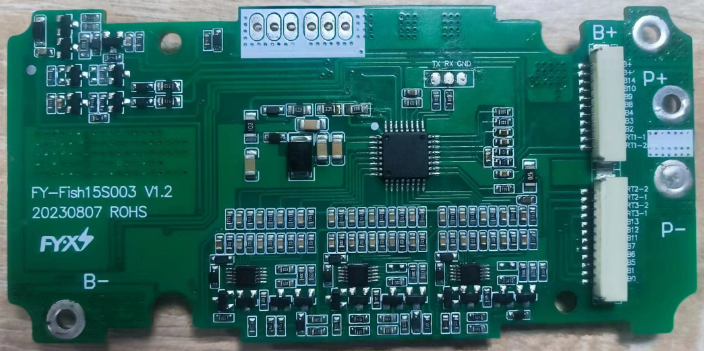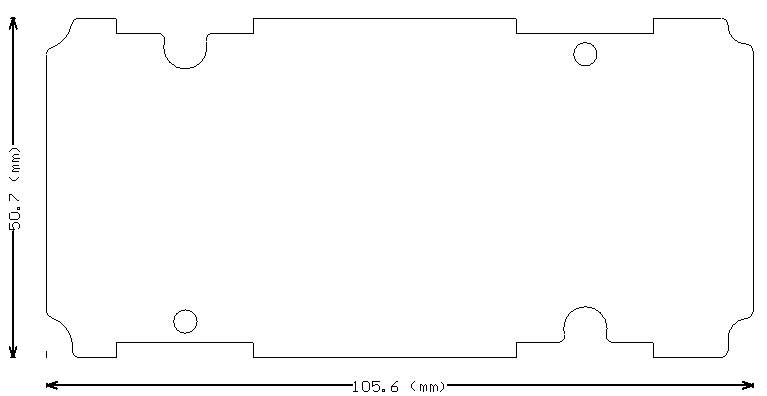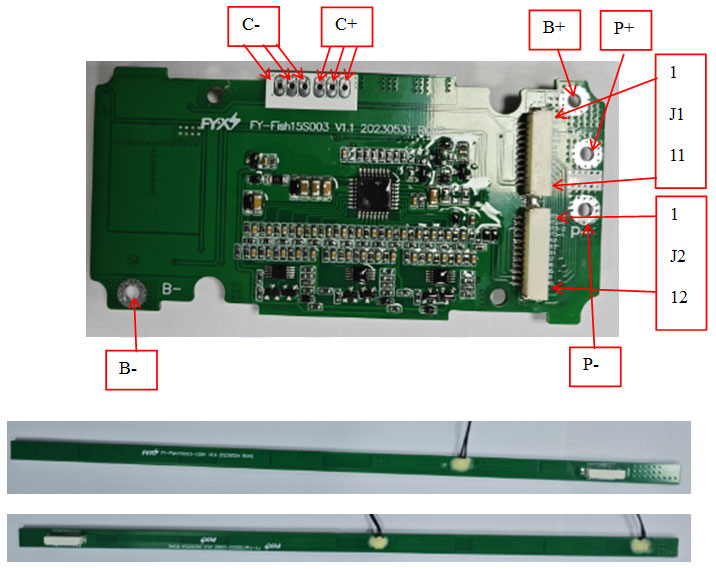As the professional manufacture, we would like to provide you FY•X high quality 15S 54V 20A Hardware BMS for E-scooter.Explore cutting-edge 15S 54V 20A hardware BMS solutions for E-scooters with FY•X, offering top-notch quality and innovation. Connect with reliable suppliers in China to elevate your electric mobility products to new heights!
This FY•X high quality 15S 54V 20A Hardware BMS for E-scooter is a BMS specially designed by Huizhou Feiyu New Energy Technology Co., Ltd. for certified unicycle battery packs. It is suitable for 15-cell lithium batteries with different chemical properties, such as lithium ion, lithium polymer, lithium iron phosphate, etc.With double charging and discharging protection, it is safer. The protection board has strong load capacity and the maximum sustainable discharge current can reach 20A.
● 15 batteries are protected in series.
●Charging and discharging voltage, current, temperature and other protection functions.
● Output short circuit protection function.
● 3-way temperature detection.
●Charge and discharge secondary protection function.
● The charging port has anti-reverse charging function.

BMS front view, for reference only

BMS back side picture, for reference only

Physical picture of the front of adapter board 1, for reference only

Actual picture of the reverse side of adapter board 1, for reference only

Front view of adapter board 2, for reference only

Actual picture of the reverse side of adapter board 2, for reference only
|
Specification |
Min. |
Typ. |
Max |
Error |
Unit |
|||||
|
Battery |
||||||||||
|
Battery Type |
LiCoxNiyMnzO2 |
|
||||||||
|
Number of battery strings |
15S |
|
||||||||
|
absolute maximum ratings |
||||||||||
|
Charging voltage input |
|
63 |
|
±1% |
V |
|||||
|
recharging current |
|
3 |
5 |
|
A |
|||||
|
Discharge output voltage |
40.5 |
55.5 |
63 |
|
V |
|||||
|
Discharge output current |
|
|
20 |
|
A |
|||||
|
Sustainable working current |
≤20 |
A |
||||||||
|
environmental conditions |
||||||||||
|
Operating temperature |
-30 |
|
75 |
|
℃ |
|||||
|
humidity |
0% |
|
|
|
RH |
|||||
|
store |
||||||||||
|
Storage temperature |
-20 |
|
65 |
|
℃ |
|||||
|
Storage humidity |
0% |
|
|
|
RH |
|||||
|
Protection parameters |
||||||||||
|
One-time overcharge protection value |
|
4.22 |
|
±50mV |
V |
|||||
|
One time overcharge protection delay |
|
1 |
|
|
S |
|||||
|
One-time overcharge release value |
|
4.12 |
|
±50mV |
V |
|||||
|
|
|
|
|
|
|
|||||
|
Secondary overcharge protection value |
|
4.225 |
|
±50mV |
V |
|||||
|
Secondary overcharge protection delay |
|
1 |
|
|
S |
|||||
|
Second overcharge release value |
|
4.075 |
|
±50mV |
V |
|||||
|
|
|
|
|
|
|
|||||
|
One-time over-discharge protection value |
|
2.7 |
|
±100mV |
V |
|||||
|
One-time over-discharge protection delay |
|
1 |
|
|
S |
|||||
|
One-time over-discharge protection release value |
|
3.0 |
|
±100mV |
V |
|||||
|
|
|
|
|
|
|
|||||
|
Secondary over-discharge protection value |
|
2.7 |
|
±100mV |
V |
|||||
|
Secondary over-discharge protection delay |
|
1 |
|
|
S |
|||||
|
Secondary over-discharge protection release value |
|
3.0 |
|
±100mV |
V |
|||||
|
|
|
|
|
|
|
|||||
|
Charging overcurrent protection value |
|
30 |
|
|
A |
|||||
|
Charging overcurrent protection delay |
|
1 |
|
|
S |
|||||
|
Charging overcurrent protection release conditions |
Disconnect the charger and release automatically after delaying 30±5s |
|||||||||
|
Charging circuit FUSE |
6A |
|||||||||
|
|
FUSE fuse is unrecoverable |
|||||||||
|
|
|
|||||||||
|
Discharge overcurrent 1 protection value |
42 |
47 |
52 |
|
A |
|||||
|
Discharge overcurrent 1 protection delay |
0.7 |
1 |
1.3 |
|
S |
|||||
|
Discharge overcurrent 1 release conditions |
disconnect load release |
|||||||||
|
Discharge overcurrent 2 protection value |
90 |
100 |
110 |
|
A |
|||||
|
Discharge overcurrent 2 protection delay |
70 |
100 |
130 |
|
mS |
|||||
|
Discharge overcurrent 2 release conditions |
disconnect load release |
|||||||||
|
Discharge short circuit protection value |
170 |
200 |
230 |
|
A |
|||||
|
Discharge short circuit protection delay |
|
320 |
500 |
|
uS |
|||||
|
Discharge short circuit protection release conditions |
disconnect load release |
|||||||||
|
Discharge circuit FUSE |
40A |
|||||||||
|
|
FUSE fuse is unrecoverable |
|||||||||
|
|
|
|||||||||
|
Discharge high temperature protection value |
65 |
70 |
75 |
|
℃ |
|||||
|
Discharge high temperature release value |
60 |
65 |
65 |
|
℃ |
|||||
|
Discharge low temperature protection value |
-25 |
-20 |
-15 |
|
℃ |
|||||
|
Discharge low temperature release value |
-20 |
-15 |
-10 |
|
℃ |
|||||
|
Charging high temperature protection value |
42 |
47 |
53 |
|
℃ |
|||||
|
Charging high temperature release value |
37 |
42 |
43 |
|
℃ |
|||||
|
Charging low temperature protection value |
-10 |
-5 |
0 |
|
℃ |
|||||
|
Charging low temperature release value |
-5 |
0 |
5 |
|
℃ |
|||||
|
Secondary charging high temperature protection value |
45 |
50 |
53 |
|
℃ |
|||||
|
Secondary charging high temperature release value |
40 |
45 |
50 |
|
℃ |
|||||
|
humidity |
|
|
|
|
|
|||||
|
Power consumption parameters |
||||||||||
|
Normal power consumption |
|
85 |
150 |
|
uA |
|||||
|
Power consumption after undervoltage |
|
45 |
100 |
|
uA |
|||||

Dimensions 105.6*50.7 Unit: mm Tolerance: ±0.5mm
Protection board thickness: less than 15mm (including components)

Dimensions 338.75*10 Unit: mm Tolerance: ±0.5mm

Protection board wiring diagram
The protection board detection line terminals are:
1. 11PIN/SMD/1.25mm/horizontal/with buckle terminal seat
2. 12PIN/SMD/1.25mm/horizontal/with buckle terminal seat
Protective board and adapter board supporting wires:
1. DIP material\wire\11PIN\1.25mm\3302#28A 70mm forward dual plug with buckle (1 red 10 white)
2. DIP material\wire\12PIN\1.25mm\3302#28A 70mm forward double plug buckle (1 black 11 white)
Adapter board matching NTC: plug-in NTC\10K\1%\3435\90mm tadpole type\28#PVC line 3PCS
|
Item |
Details |
|
|
B+ |
Connect to Positive Side of the pack. |
|
|
B- |
Connect to Negative Side of the pack. |
|
|
P+ |
Discharging Positive Port. |
|
|
P- |
Discharging Negative Port. |
|
|
C+ |
Charging Positive Port. |
|
|
C- |
Charging Negative Port. |
|
|
|
|
|
|
J1 |
1 |
B+ Connect to Positive Side of the pack. |
|
2 |
B+ Connect to Positive Side of the pack. |
|
|
3 |
B14 Connect to Positive Side of Cell 14 |
|
|
4 |
B10 Connect to Positive Side of Cell 10 |
|
|
5 |
B9 Connect to Positive Side of Cell 9 |
|
|
6 |
B8 Connect to Positive Side of Cell 8 |
|
|
7 |
B4 Connect to Positive Side of Cell 4 |
|
|
8 |
B3 Connect to Positive Side of Cell 3 |
|
|
9 |
B2 Connect to Positive Side of Cell 2 |
|
|
10 |
RT1-1 NTC1 1 pin |
|
|
11 |
RT1-2 NTC1 2 pins |
|
|
J2 |
1 |
RT2-2 NTC2 2 pins |
|
2 |
RT2-1 NTC2 1 pin |
|
|
3 |
RT3-2 NTC3 2 pins |
|
|
4 |
RT3-1 NTC3 1 pin |
|
|
5 |
B13 Connect to Positive Side of Cell 13 |
|
|
6 |
B12 Connect to Positive Side of Cell 12 |
|
|
7 |
B11 Connect to Positive Side of Cell 11 |
|
|
8 |
B7 Connect to Positive Side of Cell 7 |
|
|
9 |
B6 Connect to Positive Side of Cell 6 |
|
|
10 |
B5 Connect to Positive Side of Cell5 |
|
|
11 |
B1 Connect to Positive Side of Cell 1 |
|
|
12 |
B0 Connect to Negative Side of Cell1 |
|

Schematic diagram of battery connection sequence
Warning: When connecting the protective plate to the battery cells or removing the protective plate from the battery pack, the following connection sequence and regulations must be followed; if operations are not performed in the required order, the components of the protective plate will be damaged, resulting in the protective plate being unable to protect the battery. core, causing serious consequences.
Preparation: As shown in Figure 11, connect the corresponding voltage detection cable to the corresponding battery core. Please pay attention to the order in which the sockets are marked.
Steps to install protective board:
Step 1: First install the two adapter plates to the corresponding positions of the battery pack, and spot weld the corresponding nickel sheets
Step 2: Solder the P+/P-/C+/C- lines to the P+/P-/C+/C- pads of the protection board without connecting the charger and load;
Step 3: Connect the negative pole of the battery pack to B- of the protection board;
Step 4: Connect the positive terminal of the battery pack to B+ of the protection board;
Step 5: Connect the terminals on the adapter board to the J1/J2 sockets plugged into the protection board through the adapter cable;
Steps to remove the protective plate:
Step 1: Disconnect all chargers\loads
Step 2: Unplug the adapter cable between the adapter board and the protection board
Step 3: Remove the connecting wire connecting the positive electrode of the battery pack from the B+ pad of the protective plate
Step 4: Remove the connecting wire connecting the negative electrode of the battery pack from the B- pad of the protective plate
Additional notes: Please pay attention to electrostatic protection during production operations.
|
|
Device type |
model |
encapsulation |
brand |
Dosage |
Location |
|
1 |
Chip IC |
SH3676016B |
LQFP32 |
Saiwei |
1PCS |
|
|
2 |
Chip IC |
CW1252BTAM |
MSOP10 |
Saiwei |
3PCS |
|
|
3 |
SMD MOS |
CRSS038N08N |
TO263 |
China Resources Micro |
4PCS |
|
|
4 |
SMD MOS |
TSB5D2N095B |
TO263 |
Ziguangwei |
2PCS |
|
|
5 |
SMD FUSE |
STE2400 |
2410 |
Olite |
1PCS |
|
|
6 |
SMD FUSE |
R12.000.6 |
1206 |
Olite |
1PCS |
|
|
|
Plug-inNTC |
10K\1%\3435 |
90mm tadpole type\28#PVC line |
Jinglin |
3PCS |
|
|
7 |
PCB |
Fish15S003 V1.2 |
105.6*50.7*1.6mm |
|
1PCS |
|
|
|
|
|
|
|
||
|
Fish15S003-CON1 V1.1 |
338.75*10*1.6mm |
|
1PCS |
|
||
|
Fish15S003-CON2 V1.1 |
338.75*10*1.6mm |
|
1PCS |
|
Note: If SMD transistor: MOS tube is out of stock, our company may replace it with other models with similar specifications, and we will communicate and confirm.

1.Feiyu company logo;
2.Protection board model - (This protection board model is Fish15S003, other types of protection boards are marked, there is no limit to the number of characters in this item)
3.The number of battery strings supported by the required protection board - (this model of protection board is suitable for 15S battery packs);
4.Charging current value - 5A means the maximum support for continuous 5A charging;
5.Discharge current value - 20A means the maximum support for continuous charging is 20A;
6.Balance resistance size - fill in the value directly, for example, 100R, then the balance resistance is 100 ohms;
7.Battery type - one digit, the specific serial number indicates the battery type as follows;
|
1 |
Polymer |
|
2 |
LiMnO2 |
|
3 |
LiCoO2 |
|
4 |
LiCoxNiyMnzO2 |
|
5 |
LiFePO4 |
8.The model number of this protection board is: FY-Fish15S003-15S-5A-20A-0R-4-V1.2. Please place the order according to this model number when placing bulk orders.
1. When performing charge and discharge tests on the battery pack with the protective board installed, please do not use a battery aging cabinet to measure the voltage of each cell in the battery pack, otherwise the protective board and battery may be damaged.
2. This protection board does not have a 0V charging function. Once the battery reaches 0V, the battery performance will be severely degraded and may even be damaged. In order not to damage the battery, the user should not charge the battery for a long time (the battery pack capacity is greater than 15AH, and the storage exceeds 1 Months) When not in use, it needs to be charged regularly to replenish the battery; when in use, it must be charged in time within 12 hours after being discharged to prevent the battery from being discharged to 0V due to self-consumption. Customers are required to have an obvious sign on the battery casing that the user regularly maintains the battery.
3. This protection board does not have reverse charging protection function. If the polarity of the charger is reversed, the protection board may be damaged.
4. This protective board shall not be used in medical products or products that may affect personal safety.
5. Our company will not be responsible for any accidents caused by the above reasons during the production, storage, transportation and use of the product.
6. This specification is a performance confirmation standard. If the performance required by this specification is met, our company will change the model or brand of some materials according to the order materials without further notification.
7. The short-circuit protection function of this management system is suitable for a variety of application scenarios, but it does not guarantee that it can be short-circuited under any conditions. When the total internal resistance of the battery pack and short-circuit loop is less than 40mΩ, the battery pack capacity exceeds the rated value by 20%, the short-circuit current exceeds 1500A, the inductance of the short-circuit loop is very large, or the total length of the short-circuited wire is very long, please test by yourself to determine whether This management system can be used.
8. When welding battery leads, there must be no wrong connection or reverse connection. If it is indeed connected incorrectly, the circuit board may be damaged and needs to be retested before it can be used.
9. During assembly, the management system should not directly contact the surface of the battery core to avoid damaging the circuit board. The assembly must be firm and reliable.
10. During use, be careful not to touch the lead tips, soldering iron, solder, etc. on the components on the circuit board, otherwise the circuit board may be damaged.Pay attention to anti-static, moisture-proof, waterproof, etc. during use.
11. Please follow the design parameters and usage conditions during use, and the values in this specification must not be exceeded, otherwise the management system may be damaged. After assembling the battery pack and management system, if you find no voltage output or failure to charge when you power on for the first time, please check whether the wiring is correct.
Note: After your company receives the prototype and specifications, please reply promptly. If there is no reply within 7 days, our company will regard your company as having recognized the specifications and send the prototype. If your order exceeds 50 PCS, you need to sign back the acknowledgment letter. If you do not sign back, our company will also regard your company as having approved this specification and send the sample machine. The pictures in the specification are of general-purpose models, which may be slightly different from the sample delivered. Feiyu reserves the right of final interpretation of this specification.
DISCLAIM:
In order to improve the design or performance and to supply the best possible products, Feiyu reserves the right to make changes to the products contained in this data sheet. Feiyu assumes no responsibility for the use of any circuits shown in this data sheet, conveys no license under any patent or other rights, and makes no claim that the circuits are free from patent infringement. Applications for any devices shown in this data sheet are for illustration only and Feiyu makes no claim or warranty that such applications will be suitable for the use specified without further testing or modification.
LIFE RELATED POLICY:
In situations where semiconductor component failure may endanger life, system designers using this product should design the system with appropriate error detection and correction, redundancy and back-up features to prevent such an occurrence.
Feiyu’s products are not authorized for use in critical components in life support devices or systems.
1. Life support devices or systems are devices or systems which, (a) are intended for surgical implant into the body, or (b) support or sustain life, and whose failure to perform, when properly used in accordance with instructions for use provided in the labeling, can be reasonably expected to result in a significant injury to the user.
2. A critical component is any component of a life support device or system whose failure to perform can be reasonably expected to cause the failure of the life support device or system, or to affect its safety or effectiveness.